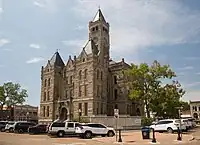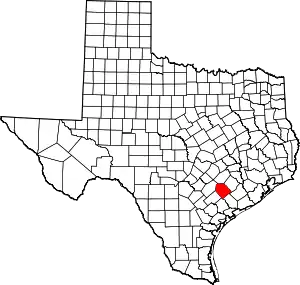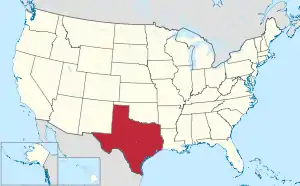Lavaca County | |
|---|---|
 The Lavaca County Courthouse in Hallettsville | |
 Location within the U.S. state of Texas | |
 Texas's location within the U.S. | |
| Coordinates: 29°23′N 96°56′W / 29.38°N 96.94°W | |
| Country | |
| State | |
| Founded | 1846 |
| Named for | Lavaca River |
| Seat | Hallettsville |
| Largest city | Yoakum |
| Area | |
| • Total | 970 sq mi (2,500 km2) |
| • Land | 970 sq mi (2,500 km2) |
| • Water | 0.7 sq mi (2 km2) 0.08% |
| Population (2020) | |
| • Total | 20,337 |
| • Density | 21/sq mi (8.1/km2) |
| Time zone | UTC−6 (Central) |
| • Summer (DST) | UTC−5 (CDT) |
| Congressional district | 27th |
| Website | www |
Lavaca County (/ləˈvɑːkə/ ⓘ lə-VAH-kə) is a county located in the U.S. state of Texas. As of the 2020 census, its population was 20,337.[1] Its county seat is Hallettsville.[2] The county was created in 1846.[3] It is named for the Lavaca River, which curves its way southeast through Moulton and Hallettsville before reaching the coast at Matagorda Bay.[4]
Geography
According to the U.S. Census Bureau, the county has a total area of 970 square miles (2,500 km2), of which 0.7 square miles (1.8 km2) (0.08%) is covered by water.[5]
Major highways
Adjacent counties
- Fayette County (north)
- Colorado County (northeast)
- Jackson County (southeast)
- Victoria County (south)
- DeWitt County (southwest)
- Gonzales County (northwest)
Demographics
| Census | Pop. | Note | %± |
|---|---|---|---|
| 1850 | 1,571 | — | |
| 1860 | 5,945 | 278.4% | |
| 1870 | 9,168 | 54.2% | |
| 1880 | 13,641 | 48.8% | |
| 1890 | 21,887 | 60.5% | |
| 1900 | 28,121 | 28.5% | |
| 1910 | 26,418 | −6.1% | |
| 1920 | 28,964 | 9.6% | |
| 1930 | 27,550 | −4.9% | |
| 1940 | 25,485 | −7.5% | |
| 1950 | 22,159 | −13.1% | |
| 1960 | 20,174 | −9.0% | |
| 1970 | 17,903 | −11.3% | |
| 1980 | 19,004 | 6.1% | |
| 1990 | 18,690 | −1.7% | |
| 2000 | 19,210 | 2.8% | |
| 2010 | 19,263 | 0.3% | |
| 2020 | 20,337 | 5.6% | |
| 2021 (est.) | 20,544 | 1.0% | |
| U.S. Decennial Census[6] 1850–2010[7] 2010[8] 2020[9] | |||
| Race / Ethnicity | Pop 2010[8] | Pop 2020[9] | % 2010 | % 2020 |
|---|---|---|---|---|
| White alone (NH) | 14,674 | 14,564 | 76.18% | 71.61% |
| Black or African American alone (NH) | 1,255 | 1,173 | 6.52% | 5.77% |
| Native American or Alaska Native alone (NH) | 30 | 30 | 0.16% | 0.15% |
| Asian alone (NH) | 56 | 74 | 0.29% | 0.36% |
| Pacific Islander alone (NH) | 17 | 5 | 0.09% | 0.02% |
| Some other race alone (NH) | 18 | 31 | 0.09% | 0.15% |
| Mixed/multiracial (NH) | 136 | 524 | 0.71% | 2.58% |
| Hispanic or Latino (any race) | 3,077 | 3,936 | 15.97% | 19.35% |
| Total | 19,263 | 20,337 | 100.00% | 100.00% |
Note: the US Census treats Hispanic/Latino as an ethnic category. This table excludes Latinos from the racial categories and assigns them to a separate category. Hispanics/Latinos can be of any race.
As of the census[10] of 2000, 19,210 people, 7,669 households, and 5,391 families were residing in the county. The population density was 20 people per square mile (7.7 people/km2). The 9,657 housing units had an average density of 10 units per square mile (3.9 units/km2). The racial makeup of the county was 86.86% White, 6.79% African American, 0.19% Native American, 0.16% Asian, 4.86% from other races, and 1.14% from two or more races. About 11.36% of the population were Hispanics or Latinos of any race. Of descent, 27.0% were of Czech, 24.1% German, 9.1% American, and 5.1% Irish ancestry according to Census 2000; 86.3% spoke English, 7.7% Spanish, 4.6% Czech and 1.2% German as their first language. In terms of ancestry in 2016, 32.8% were of German, 30.7% were of Czech, 10.8% were of Irish, 5.4% were of English, 3.4% were of American, and 2.2% were French.
Of the 7,669 households, 30.0% had children under 18 living with them, 57.7% were married couples living together, 9.3% had a female householder with no husband present, and 29.7% were not families. About 27.6% of all households were made up of individuals, and 16.6% had someone living alone who was 65 or older. The average household size was 2.44, and the average family size was 2.98.
In the county, the age distribution was 24.2% under 18, 6.90% from 18 to 24, 23.50% from 25 to 44, 23.60% from 45 to 64, and 21.80% who were 65 or older. The median age was 42 years. For every 100 females, there were 93.10 males. For every 100 females 18 and over, there were 88.50 males.
The median income for a household was $29,132, and for a family was $36,760. Males had a median income of $26,988 versus $17,537 for females. The per capita income for the county was $16,398. About 10.20% of families and 13.20% of the population were below the poverty line, including 15.20% of those under age 18 and 18.40% of those age 65 or over.
Education
These school public school districts are located in Lavaca County:
Communities
Cities
- Hallettsville (county seat)
- Shiner
- Yoakum (partly in DeWitt County)
Town
Unincorporated communities
Politics
Lavaca County is a very conservative county and has been getting more conservative since 1992. The last Democrat to win the county was Jimmy Carter in 1976. Donald Trump carried it substantially in the 2020 presidential election. His margin was over 70% against Joe Biden.
| Year | Republican | Democratic | Third party | |||
|---|---|---|---|---|---|---|
| No. | % | No. | % | No. | % | |
| 2020 | 8,804 | 86.34% | 1,333 | 13.07% | 60 | 0.59% |
| 2016 | 7,347 | 84.79% | 1,170 | 13.50% | 148 | 1.71% |
| 2012 | 6,796 | 81.74% | 1,428 | 17.18% | 90 | 1.08% |
| 2008 | 6,293 | 76.30% | 1,869 | 22.66% | 86 | 1.04% |
| 2004 | 5,974 | 73.06% | 2,152 | 26.32% | 51 | 0.62% |
| 2000 | 5,288 | 70.08% | 2,171 | 28.77% | 87 | 1.15% |
| 1996 | 3,697 | 53.93% | 2,575 | 37.56% | 583 | 8.50% |
| 1992 | 3,362 | 43.24% | 2,700 | 34.72% | 1,714 | 22.04% |
| 1988 | 4,377 | 54.97% | 3,531 | 44.35% | 54 | 0.68% |
| 1984 | 5,058 | 67.15% | 2,464 | 32.71% | 10 | 0.13% |
| 1980 | 3,254 | 54.24% | 2,678 | 44.64% | 67 | 1.12% |
| 1976 | 2,466 | 41.35% | 3,458 | 57.98% | 40 | 0.67% |
| 1972 | 3,288 | 69.65% | 1,429 | 30.27% | 4 | 0.08% |
| 1968 | 1,698 | 31.95% | 2,165 | 40.74% | 1,451 | 27.31% |
| 1964 | 1,480 | 26.83% | 4,031 | 73.07% | 6 | 0.11% |
| 1960 | 1,507 | 27.29% | 4,002 | 72.47% | 13 | 0.24% |
| 1956 | 2,509 | 50.78% | 2,412 | 48.82% | 20 | 0.40% |
| 1952 | 3,599 | 56.58% | 2,750 | 43.23% | 12 | 0.19% |
| 1948 | 1,165 | 25.83% | 3,046 | 67.52% | 300 | 6.65% |
| 1944 | 960 | 19.37% | 3,406 | 68.74% | 589 | 11.89% |
| 1940 | 1,412 | 36.81% | 2,419 | 63.06% | 5 | 0.13% |
| 1936 | 403 | 15.38% | 2,204 | 84.12% | 13 | 0.50% |
| 1932 | 224 | 4.86% | 4,378 | 94.91% | 11 | 0.24% |
| 1928 | 911 | 24.27% | 2,842 | 75.73% | 0 | 0.00% |
| 1924 | 746 | 14.15% | 3,290 | 62.42% | 1,235 | 23.43% |
| 1920 | 100 | 3.13% | 1,249 | 39.10% | 1,845 | 57.76% |
| 1916 | 936 | 31.55% | 1,784 | 60.13% | 247 | 8.32% |
| 1912 | 265 | 12.30% | 1,455 | 67.52% | 435 | 20.19% |
See also
References
- ↑ "Lavaca County, Texas". United States Census Bureau. Retrieved January 30, 2022.
- ↑ "Find a County". National Association of Counties. Retrieved June 7, 2011.
- ↑ "Texas: Individual County Chronologies". Texas Atlas of Historical County Boundaries. The Newberry Library. 2008. Retrieved May 25, 2015.
- ↑ Gannett, Henry (1905). The Origin of Certain Place Names in the United States. U.S. Government Printing Office. p. 182.
- ↑ "2010 Census Gazetteer Files". United States Census Bureau. August 22, 2012. Retrieved May 3, 2015.
- ↑ "Decennial Census of Population and Housing by Decades". US Census Bureau.
- ↑ "Texas Almanac: Population History of Counties from 1850–2010" (PDF). Texas Almanac. Archived (PDF) from the original on October 9, 2022. Retrieved May 3, 2015.
- 1 2 "P2 HISPANIC OR LATINO, AND NOT HISPANIC OR LATINO BY RACE - 2010: DEC Redistricting Data (PL 94-171) - Lavaca County, Texas". United States Census Bureau.
- 1 2 "P2 HISPANIC OR LATINO, AND NOT HISPANIC OR LATINO BY RACE - 2020: DEC Redistricting Data (PL 94-171) - Lavaca County, Texas". United States Census Bureau.
- ↑ "U.S. Census website". United States Census Bureau. Retrieved May 14, 2011.
- ↑ Leip, David. "Dave Leip's Atlas of U.S. Presidential Elections". uselectionatlas.org. Retrieved July 26, 2018.